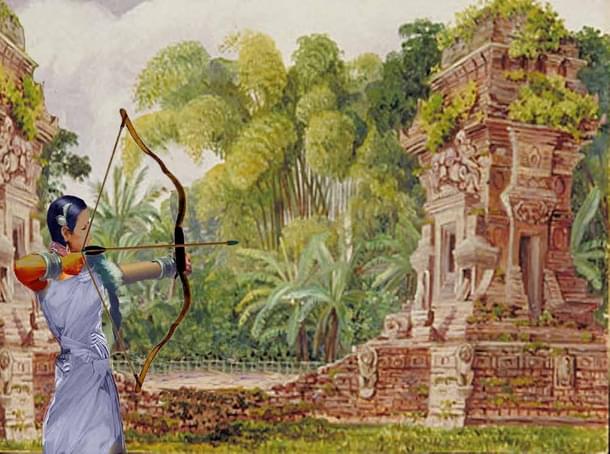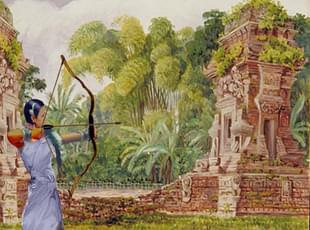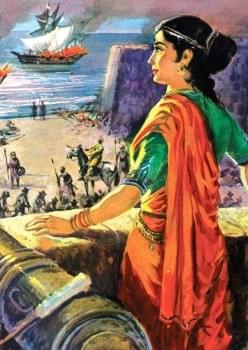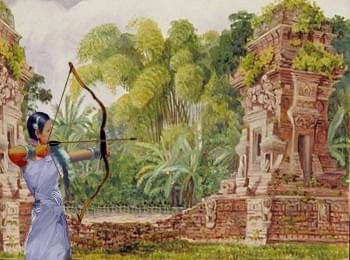Magazine
The Admiral Queen
Archana Garodia Gupta
Oct 25, 2015, 02:30 PM | Updated Feb 11, 2016, 08:49 AM IST
Save & read from anywhere!
Bookmark stories for easy access on any device or the Swarajya app.


The legendary story of Rani Abbakka, the queen who had fought off the Portugese and much more in the 16th century.
“Her Complexion was as black as that of a natural Ethiopian;… She was girded at the waist, with a plain piece of thick white Cotton, and barefoot,…From the waist upwards the Queen was naked…In brief, her aspect and habit represented rather a dirty Kitchen wench, or Laundress, than a delicate and noble Queen; whereupon I said within myself. Behold by whom are routed in India the Armies of the King of Spain which in Europe is so great a matter!”
—Pietro Della Valle, Italian traveller
Rani Abbakka Chowta was the legendary queen of Ullal near Mangalore, who fought off the Portuguese during the 16th and 17th centuries. Historically, there are considered to be three queens of the same name who ruled from the 1540s to at least the 1620s, and there are many successful tales of valour associated with each of them. There was a queen Abbakka who fought the Portuguese in 1557 and 1568. There is another queen Abbakka who gained a great naval victory in 1618 and who was 40 years old when Pietro Della Valle, an Italian traveler, met her in 1623.
These queens kept the strategic port of Ullal in Indian hands, and often bested the Portuguese in naval battles, which brought them renown across the Indian Ocean, in the courts of Iran and Arabia, as well as Europe. In legend, she is commemorated as a great queen, Abbakka Mahadevi, a little like the Phantom in the comics by Lee Falk. She was known as the Abhaya Rani, for her fearlessness, and is considered the first Indian woman freedom fighter against colonialism.
She belonged to the Chowta dynasty. The Chowtas were a Digambar Jain dynasty who had migrated from Gujarat in probably the 12th century. They ruled in coastal Canara, in Tulu Nadu. Their main centre was Moodibidri, known as Jain Dakshin Kashi, as it was a cultural centre with beautiful Jain temples, and centres of Jain scholarship. Descendants of Chowta kings still live in the Chowta Palace with its beautiful carvings in Moodibidri.
The Chowtas ruled over a small but fertile part of coastal Canara. Ullal was 10 km from Mangalore, which had been an important port for export of spices and textiles since antiquity. Mangalore had been mentioned by both Pliny and Ptolemy. Trade routes with the Arabs had been established as early as the seventh century and there were many local Muslim trading communities like the Maplah of Kerala and the Biary of Tulu Nadu, who were involved in the maritime trade of pepper and ginger. It was also a very important port for the kingdom of Vijayanagara, through which they imported their all important source of power, the war horses brought in by the Arabs. The Chowtas were feudatories of the great Vijayanagara kingdom, and were under the supervision of the Nayaks of Keladi from the 16th century onwards.
On this fertile spice coast descended the Portuguese, who were the first Europeans to finally find a sea route to India in 1498 under Vasco da Gama. In 1503, they built their first fort in Cochin. With their superior naval technology, they quickly established total dominance of the Indian Ocean, creating a ring of forts around it, some of them in Mozambique, Muscat, West Bengal, Sri Lanka, and eventually further in the Malaccas, the Indonesian islands, Macau in China, and in Japan. The Portuguese now controlled the entire spice route, within 20 years of Vasco Da Gama’s voyage.
During the whole of the 16th century, for a hundred years, the Indian Ocean was a Portuguese lake. No other European power challenged them—the Dutch and the English only made their way there by the beginning of the 17th century. The Portuguese would not let any other ships trade on the Indian Ocean, or only with a Portuguese permit (cartaz), which they charged for (naturally). The Indian Ocean, which had hitherto been a free trade zone with Arab, Egyptian, Persian and Indian ships, became a Portuguese pond. Even Mughal emperor Akbar had to take a cartaz from them for any ships travelling on the Indian Ocean. During this time, though they engaged in many battles with Indian navies that were many times their size, the Portuguese superiority in weaponry meant that they invariably won.

In India, under Afonso de Albuquerque, one of the most successful Portuguese “Governors of India”, the Portuguese made great advances, and captured many territories, including Goa in 1510, from the Bijapur Sultanate. They established Goa as their capital in the Indian Ocean. Over time, they also created bases at various ports along the Western Indian coast, such as at Daman, Salsette, Bombay, and Diu. For the people of Asia, the brutality and savagery of the Portuguese was a shock.
However, each advance was bitterly fought by the smaller kingdoms along the coast like Ullal and Kozhikode, who had traded directly with the Arabs, and now refused to knuckle under. There were naval engagements, and their cities were often attacked and cannonaded by the Portuguese, but they did not give up. Many of these kingdoms were finally annexed by the British after the fall of Tipu Sultan in 1799.
In 1526, the Portuguese, under their viceroy Lopo Vaz de Sampaio, took possession of Mangalore port. Ullal was just across the water. It was then ruled by Thirumala Raya III. The Chowtas followed a matrilineal system, but were not matriarchal. This is an interesting system, followed in some communities like the Nairs in Kerala, in which the inheritance descends from the female line, but the rule is by the male. The ruler’s sister’s son becomes the King. Unusually, since Thirumala Raya had no nephews, he trained his niece Abbakka in princely crafts like military science, archery, and sword fighting. In local legends, of course, she was a visionary child, unequalled in her capabilities in all the arts and sciences!
A strategic match was arranged for her with the King Lakshmappa Bangaraja of Mangalore. As per the system in matrilineal societies, she continued to live in her own home, the married couple met periodically, and her three children stayed with her. The marriage was fractured, as per legend, because of her desire to fight the Portuguese, and his to compromise. She is supposed to have sent back her jewellery, which was tantamount to a divorce.
This Abbakka Devi is supposed to have ruled from 1544 to 1582, while Lakshmappa Bangaraja II ruled from 1545 to 1556. His nephew, Kamaraya III, who was supposed to have intrigued with the Portuguese against his uncle, and later supported them against Rani Abbakka, was in power from 1556 to 1612.
Rani Abbakka ruled over a multi-religious kingdom. Though she was a Jain, her people and administration largely consisted of Hindus and Muslims. Her army was also diverse; in particular, men of the Mogaveera Muslim fishermen community were a great strength for her in the naval battles with the Portuguese.
Rani Abbakka was not willing to accept the Portuguese embargo on her ships travelling to the Middle East, and she would send spices, fabrics etc with the help of the Zamorin of Kozhikode. Her ships were attacked at sea by the Portuguese, but many would make it back. She also refused to pay the Portuguese the tribute they demanded.

In 1555, the Portuguese finally sent Admiral Don Alvaro da Silveira against Ullal, She fought hard and managed to hold them back. The battle ended in an uneasy truce.
Then Vijayanagara fell in the battle of Talikota in 1565, and the Portuguese became emboldened in their attacks on the erstwhile feudatories of the kingdom.
In 1567, the Portuguese army attacked Ullal under General Joao Peixoto. He captured the city and occupied the palace. However the Queen managed to escape and hide in a mosque. In the dead of night, with 200 soldiers, she raided the Portuguese and managed to kill General Peixoto and 70 soldiers. The invaders fled to their ships. She followed and killed Admiral Mascarenhas.
She formed an alliance in 1570 with the sultans of Bijapur and Ahmed Nagar, and the Zamorin of Kozhikode against the Portuguese,
In 1581, the Goa Viceroy Anthony D’ Noronha led an attack against Ullal with a grand Armada. Ullal fell, and was destroyed. The queen also died, as per legend leading her men from the front with the battle cry of “Save the motherland, fight the invaders on land and the sea and push them back to the waters!”
But this was not the end.
There rose from the ashes like a phoenix, another Abbakka. She gained great fame throughout the Indian Ocean by attacking and burning the Portuguese fleet in 1618.
In true family tradition, she had continued defying the Portuguese and trading directly with the Middle East. When the Portuguese captured a rich ship of hers returning from Mecca, she planned a secret attack. On a dark night, her fishermen soldiers, the Mogaveeras and Moplahs, got into boats, sneaked in amongst the Portuguese ships, and used thousands of agnivaans (flaming arrows) and coconut torches to set the ships on fire. The Portuguese navy had to retreat with heavy losses.
Pietro Della Valle, the Italian traveler, toured India’s west coast between 1621 to 1624. He had earlier met the Persian emperor Shah Abbas, who had praised Abbakka, and asked him to meet her when he went to India.
He managed to run her down to earth in the village of Manel, where the 40-year-old queen had gone to supervise some irrigation work. The Portuguese had decided to leave her alone.
She asked him about his journeys, and then asked, “After seeing the Great Turk, the Persian emperor, the Mughal emperor and Venkatappa Nayaka, what is there to see in this wilderness?”
“I came only to see you, Your Majesty. You are so well-known in my part of the world!” was Pietro’s answer.
An excerpt from Pietro’s travelogue on the encounter: “We beheld the Queen coming alone in the same way without any other Woman, on foot, accompany’d only with four, or six, foot Soldiers before her, each of them had a Sword in his hand, or at most a Sword and Buckler; there were also as many behind her of the same sort, one of whom carry’d over her a very ordinary Umbrella made of Palm-leaves.
“Her Complexion was as black as that of a natural Ethiopian; she was corpulent and gross, particularly in regard to her person below the waist, where her corpulence, owing to the cotton cloth which she wears, which, according to Indian fashion, is worn very tight, is very evident, but not heavy, for she seemed to walk nimbly enough; her Age may be about forty years, although the Portugals had described her to me as much older.
“She was cloth’d, or rather girded at the waist, with a plain piece of thick white Cotton, and bare-foot, which is the custom of the Indian Gentile Women, both high and low, in the house and abroad; and of Men too the most, and all the most ordinary, go unshod; some of the more grand wear Sandals, or Slippers; very few whole Shoes covering all the Foot. From the waist upwards the Queen was naked, saving that she had a cloth ty’d round about her Head, and hanging a little down upon her Breast and Shoulders.
“In brief, her aspect and habit represented rather a dirty Kitchen wench, or Laundress, than a delicate and noble Queen; whereupon I said within myself. Behold by whom are routed in India the Armies of the King of Spain which in Europe is so great a matter! Yet the Queen shew’d her quality much more in speaking than by her presence; for her voice was very graceful in comparison with her Person, and she spoke like a prudent and judicious Woman. I imagine she was handsome in her Youth; and, indeed, the Report is that she hath been much of a Lady, of majestic beauty, though stern rather than gentle.
“She was little at home, but, rising at break of day, went forthwith to her Works and there stayed till dinner; and as soon as dinner was done returned thither again and remained there till night. By which action I observed something in her of the spirit of Shah Abbas King of Persia and concluded it no wonder that she hath alwayes shew’d herself like him, that is, active and vigorous in actions of war and weighty affairs. Moreover they said that at night she was employ’d a good while in giving Audience and doing Justice to her Subjects; so that it was better to go and speak to her in the field, while she was viewing her Workmen, than in the house. “
Rani Abbakka’s story lives on in folk memory in Dakshin Karnataka, through folk songs and performances of Yakshagana, the local theatre form. In Bhuta Kola, a local ritual dance, a person in trance recounts the great deeds of Abbakka Mahadevi. In all these, Abbakka is portrayed as dark and good looking, always dressed simply as a commoner.
The Indian Navy finally acknowledged India’s rare woman naval hero, and named a patrol vessel Rani Abbakka after her in 2012.
The writer is the President of the FICCI Ladies Organisation. One of India's leading quizzers, she was declared Champion of Champions by BBC Mastermind in 2001. Archana owns and runs a successful gems and jewellery business, Touchstone, which is a pioneer in Indian costume jewellery that caters to the middle class.





